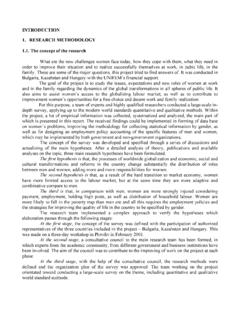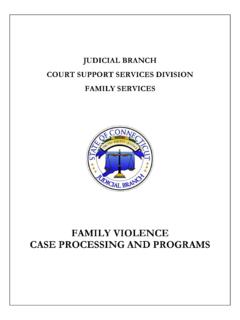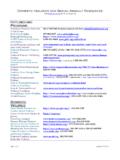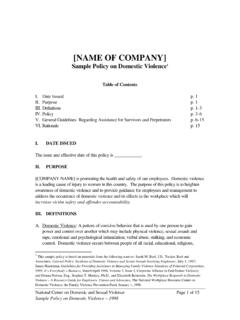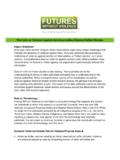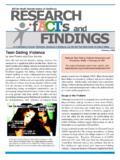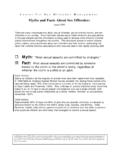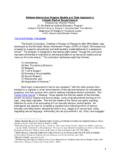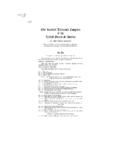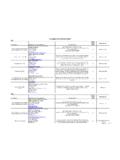Transcription of Re-presenting Battered Women: Coercive Control and the ...
1 1 Re-presenting Battered Women: Coercive Control and the Defense of Liberty * By Evan Stark , , MSW Professor, Rutgers School of Public Affairs and Administration Comments may be sent to the author at 11 Forest Trail Woodbridge CT. 06525 *Prepared for violence Against Women : Complex Realities and New Issues in a Changing World, Les Presses de l Universit du Qu bec (2012) 2 3 Throughout the world, with a few exceptions, the legal and policy responses to domestic violence are typically built on a violence model that equates partner abuse with discrete assaults or threats. Implicit in this response is the assumption that the severity of domestic violence can be assessed by applying a calculus of physical and psychological harms to particular assaults.
2 Based on this model, programs focus only on victims immediate safety. Laws target violent acts; batterer intervention programs (BIPs) seek to end the violence ; public education campaigns highlight dramatic injuries or fatalities; and child welfare agencies emphasize how children are harmed by exposure to violence . Assessment instruments designed to predict dangerousness consider few abusive tactics other than physical and sexual violence (Campbell et al. 2003). However, a growing body of research shows that the form of subjugation that drives most abused women to seek outside assistance is not encompassed by the violence model and that, therefore, interventions predicated on this model are ineffective in protecting women and children from this type of abuse.
3 These women have been subjected to a pattern of domination that includes tactics to isolate, degrade, exploit and Control them as well as to frighten them or hurt them physically. This pattern, which may include but is not limited to physical violence , has been variously termed psychological or emotional abuse, patriarchal or intimate terrorism (Tolman, 1992; Johnson, 2008), and Coercive Control (Stark, 2007), the term I prefer. Some countries have either included psychological or emotional abuse in their definitions of domestic violence or, as in France, created a separate criminal statute prohibiting psychological abuse. In September 2012, England expanded its cross-governmental definition of domestic violence to encompass Coercive Control . The new definition recognizes that patterns of behavior and separate instances of Control can add up to abuse including instances of intimidation, isolation, depriving victims of their financial independence or material possessions and regulating their everyday behavior.
4 The terms psychological and emotional abuse can be applied to certain aspects of Coercive Control , including acts designed to intimidate victims where threats remain implicit. But they are vague and easily manipulated by offenders who claim emotional abuse by victims. In addition, if a woman claims 4 psychological violence , in order to access legal remedies in some countries, she may be required to produce the expert testimony of a psychologist to prove damages or harm. Some of the tactics used in Coercive Control are criminal offenses, such as stalking, while others are crimes only if committed against strangers such as economic exploitation or deprivation, enforced isolation or sexual coercion. But most tactics used in Coercive Control have no legal standing, are rarely identified with abuse and are almost never targeted by intervention.
5 These tactics include forms of constraint and the monitoring and/or regulation of commonplace activities of daily living, particularly those associated with women s default roles as mothers, homemakers and sexual partners and run the gamut from their access to money, food and transport to how they dress, clean, cook or perform sexually. By ignoring or minimizing the tactics used in Coercive Control , current domestic violence laws also miss many of its most devastating effects. There is mounting evidence that the level of Control in abusive relationships is a better predictor than prior assaults of future sexual assault and of severe and fatal violence . This is because Coercive Control targets a victim s autonomy, equality, liberty, social supports and dignity in ways that compromise the capacity for independent, self-interested decision-making vital to escape and effective resistance to abuse.
6 Moreover, in a significant minority of abuse cases, offenders are able to subjugate and entrap female partners without the use of violence . Arrest for assaults, the provision of shelter or legal protections against violence are vital for short-term safety. But the long-term safety and independence of Battered women can only be secured if current protections against domestic violence are extended to encompass Coercive Control . This contribution argues that reliance on the violence model limits the efficacy of current interventions because it masks the scope of most partner abuse and minimizes the harms it causes. Adopting the Coercive Control model would broaden our understanding of partner abuse to more closely resemble what most victims are experiencing and so greatly improve intervention.
7 I have divided my discussion into three parts. Part I identifies the shortcomings of the violence model as the exclusive framework for responding to partner abuse. The violence model applies to only the minority of situations where abuse is limited to physical assaults and threats of physical abuse. It ignores the large majority of cases where physical assaults are accompanied by multiple non-violent tactics that can be both more devastating and more salient to victims. 5 Section II outlines the alternative model of Coercive Control , cites evidence from the and England to document the relative prevalence of its various components and shows that the presence of Control tactics predicts a range of harms, including sexual, physical and fatal violence , far better than prior assault (Glass et al.)
8 , 2004; Beck and Raghavan, 2010). The major outcome of Coercive Control is a hostage-like condition of entrapment that arises from the suppression of a victim s autonomy, rights and liberties through Coercive Control . Assessments based on Coercive Control identify the victim s vulnerability to serious injury or psychological trauma as a function her objective or structural subordination rather than of the level of physical violence . My focus is on what perpetrators do to their partners. But the political significance of Coercive Control in the typical case derives from what abusive men prevent women from doing for themselves. The Coercive Control model defines abuse as a liberty crime and sets the use of violence in the context of the abrogation of women s human rights, the realization of which is critical to overall social and economic development as well as their ability to fulfill their purposes in the world.
9 Women can be controlling as well as men. When the offender is a male, however, Coercive Control exploits and reinforces sexual inequalities in the larger society in ways that make it far more devastating than when women are controlling. Section III addresses some implications of adapting a Coercive Control for improved intervention. The priority on safety is complemented with an emphasis on liberty, autonomy, dignity and equality. To fully grasp how the forms of subjugation harm women, we must first imagine they have the same rights to personhood as men. I. The Limits of the Violent-Incident Model of Abuse Since the first programs for Battered women opened in the l970 s, many countries have criminalized physical abuse by partners, held offenders accountable through some combination of sanctions and counseling, offered victims emergency shelter and provided legal and social support for victims and their children.
10 Arrest for domestic violence now occurs in many countries. But almost none of those arrested go to jail. Nor is there compelling evidence that BIPs significantly improve victim safety (Stark, 2007). The violence Model 6 Drawn from criminal justice, the violence definition of abuse targets discrete episodes of assault whose seriousness is measured by the degree of injury or other harm inflicted or intended. Protection orders, BIPs and other interventions are predicated on the belief that there is sufficient time between assaultive episodes for victims and perpetrators to contemplate their options and make self-interested decisions to end their abuse or exit the abusive relationship. The first problem with this model is the well documented fact that physical abuse almost never consists of an isolated incident, with almost half of all reported cases involving serial abuse and many involving daily assaults.
